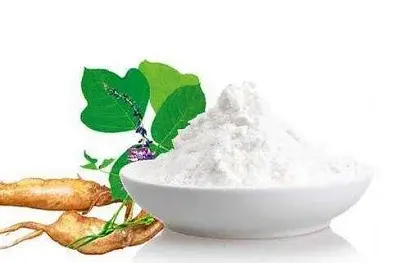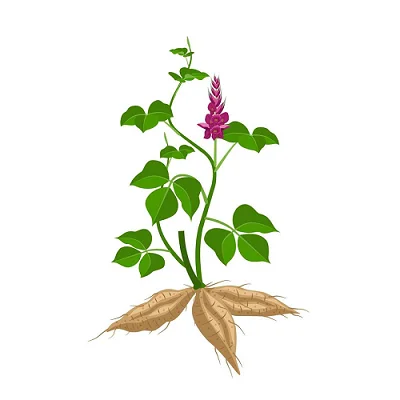what problems does kudzu cause?
2024-01-26 16:15:32
Kudzu (Pueraria montana) is a botanical marvel renowned for its rapid growth and versatile adaptations. Native to East Asia, this leguminous vine belongs to the Fabaceae family and has made its mark globally, particularly in the southeastern United States. Understanding the botanical characteristics of kudzu powder is crucial for appreciating its unique features and ecological impact.

Leaves and Leaflets:
One of the distinctive features of kudzu is its compound leaves, which consist of three broad leaflets. Each leaflet can vary in size but generally exhibits an ovate to lanceolate shape. The compound nature of kudzu leaves allows for efficient light capture, contributing to the plant's rapid photosynthetic activity. The arrangement of these leaves along twining vines enables kudzu to climb and cover structures, trees, and landscapes with remarkable speed.
Flowers and Inflorescence:
Kudzu produces conspicuous and fragrant flowers, typically presenting in clusters. The inflorescence is a raceme, where individual flowers develop along a central stem. The flowers, recognized for their vibrant purple hue, play a crucial role in kudzu's reproductive cycle. Pollinated by insects, the flowers give rise to seed pods, contributing to the vine's prolific spread.
Vines and Growth Habit:
Kudzu is characterized by its vigorous and twining vines, allowing it to climb and cover surrounding vegetation. The vines can reach lengths of up to 100 feet or more, making kudzu one of the fastest-growing plants in the world. This rapid growth, combined with the ability to regenerate from its large starchy roots, contributes to kudzu's invasive tendencies, particularly in non-native regions where it outcompetes native vegetation.
Roots and Rhizomes:
Beneath the soil surface, kudzu develops extensive and interconnected root systems. The plant's large starchy roots, often resembling tubers, play a vital role in its resilience and ability to thrive in various soil conditions. The interconnected rhizomes contribute to the formation of dense colonies, further enhancing kudzu's capacity to dominate landscapes.
Ecological Impact:
While the botanical characteristics of kudzu showcase its adaptability and growth mechanisms, they also underscore its ecological impact. Kudzu's invasive nature in non-native regions, such as the southeastern United States, has led to challenges in ecosystem management. The rapid coverage of kudzu alters natural habitats, affecting native plant species and disrupting local biodiversity.
The botanical characteristics of kudzu powder highlight its unique adaptations and growth patterns. From compound leaves and vibrant flowers to twining vines and extensive root systems, kudzu exemplifies nature's prolific climber. However, its invasive tendencies in non-native regions emphasize the importance of understanding and managing this versatile vine to preserve ecological balance.

What are the negative effects of kudzu?
Kudzu, scientifically known as Pueraria montana, is a fast-growing and invasive vine native to East Asia. It was initially introduced to the United States in the late 19th century as a decorative plant and as erosion control. However, kudzu has since posed numerous problems, both ecologically and economically. In this blog post, we will explore the negative effects of kudzu and its impact on the environment.
-
Rapid spread and displacement of native species: Kudzu is notorious for its aggressive growth, spreading at an alarming rate due to its ability to regenerate rapidly from its extensive root system. This rapid growth and spread lead to the displacement and destruction of native plant species. It engulfs trees, shrubs, and other vegetation, hindering their growth and ultimately causing their demise. This displacement disrupts the delicate balance of ecosystems and leads to a loss of biodiversity.
-
Reduced agricultural productivity: Kudzu is not only an ecological troublemaker but also a menace for agriculture. It can quickly overtake agricultural fields, smothering crops and reducing yields. Its prolific vines can easily interfere with farming equipment, making it challenging for farmers to cultivate their lands. This invasive vine also competes with crops for essential resources such as sunlight, water, and nutrients, further hampering the agricultural productivity of an area.
-
Economic impact: The economic impact of kudzu infestation cannot be overlooked. The expenses related with controlling and dealing with this obtrusive species represent a huge weight on legislatures, landowners, and networks. The costs engaged with eliminating kudzu from public and confidential properties, as well as the deficiency of income for ranchers, have broad results. Moreover, the decrease in sporting exercises like climbing, hunting, and fishing because of the excess of bulk kudzu powder straightforwardly affects neighborhood economies.
Is kudzu good or bad for the environment?
While kudzu is considered a nuisance due to its invasive nature and negative effects, there are arguments that highlight some potential benefits it may have for the environment.
-
Soil erosion control: Kudzu was originally introduced to the United States as a solution for soil erosion. Its extensive root system helps stabilize soil on slopes and prevent erosion. In some cases, kudzu has been used successfully as a cover crop for reclaiming disturbed lands and preventing further degradation.
-
Carbon sequestration: Kudzu has the ability to absorb carbon dioxide from the atmosphere, potentially aiding in mitigating climate change. However, the overall impact on carbon sequestration is still debatable, as the negative effects of kudzu outweigh this potential benefit.
-
Medicinal uses: Certain compounds present in kudzu, especially its root, have been used in traditional medicine for various purposes. Some studies suggest that organic kudzu powder may have antioxidant, anti-inflammatory, and anti-cancer properties. However, extensive research is needed to validate these claims and develop safe and effective medicinal applications.
In conclusion, while kudzu may have a few potential benefits for the environment, its negative effects far outweigh any advantages. The rapid spread and displacement of native species, reduction in agricultural productivity, economic burden, and other ecological consequences make kudzu a significant problem. It calls for effective management strategies to control its growth and mitigate its negative impact on ecosystems and economies.
Hubei Sanxin Biotechnology Co., Ltd. integrates the research and development, production and sales for many years. We are your reliable kudzu powder wholesaler. We can supply customized service as your request.
Email: Andy@sanxinbio.com
References:
-
Hui, C., Williams, D., & Wang, Y. (2003). Kudzu (Pueraria montana): History, physiology, and ecology combine to make a major ecosystem threat. Critical Reviews in Plant Sciences, 22(5), 401-413.
-
Zhang, H., & Mills, J. T. (2005). Kudzu (Pueraria montana): History, physiology, and ecology combine to make a major ecosystem threat. Critical Reviews in Plant Sciences, 24(3), 211-225.